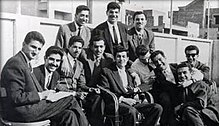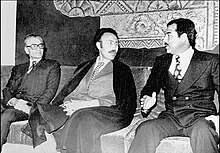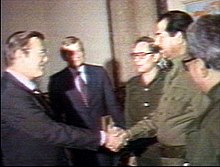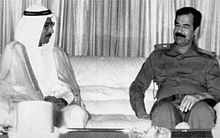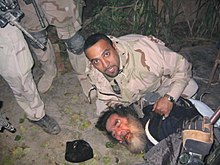Saddam Hussein
Saddam Hussein Abdulmayid al Tikriti (in Arabic, صدام حسين عبد المجيد التكريتي; Tikrit, April 28, 1937 -Baghdad, December 30, 2006) was an Iraqi politician and dictator, who served as president of his country between 1979 and 2003. Prominent member of the revolutionary Arab Socialist Baath Party and, later, of the Iraqi faction of the party and of his regional organization, Saddam played a key role in the 1968 coup (later renamed the "July 17 Revolution"), which brought the Iraqi branch of the party to power in the country.
As vice president of General Ahmed Hasan al-Bakr, and at a time when many groups were considered capable of overthrowing the government, Saddam created security forces through which he tightly controlled conflicts between the government and the armed forces. In the early 1970s, Saddam nationalized foreign oil and banks. Throughout the same decade, he cemented his authority over the government apparatus, while oil money helped Iraq's economy grow at a rapid pace. Positions of power in the country were largely held by Sunni Arabs, a minority that made up only a fifth of the population.
Saddam formally came to power in 1979, although he had already been the de facto leader of Iraq for several years. He moved away from the pro-Soviet positions of his predecessors, reaching out to the United States to form a "moderate Arab axis" with Jordan and the Egypt of the Hosni Mubarak regime. He suppressed various movements, particularly Shiites and Kurds, which sought to overthrow the government or gain independence, and held power through the Iran-Iraq War (1980-1988) and the Gulf War (1990-1991). It became popular among disaffected in the Arab world following the 1991 Iraqi launch of scud missiles at the State of Israel. Throughout more than two decades of dictatorship, the death toll attributed to Saddam's regime can be as high as a quarter of a million or more. The regime became insolvent, mainly due to the Iran-Iraq War, the Gulf War, and UN sanctions.
Promoting a Baathist interpretation of religion subordinated to nationalism, he induced an increase in religious rhetoric in Iraq in 1993 with the so-called "Campaign of Faith", reintroducing Islam in public statements and symbols from then on of the regime, despite showing himself throughout his entire presidency against any form of political Islamism.
In March 2003, a US-led coalition invaded Iraq under the pretext of Iraq's alleged possession of weapons of mass destruction and ties to Al-Qaeda. The regime was quickly overthrown, but the weapons never appeared and a new phase of conflict began, maintained between the occupation forces and the Iraqi insurgency. Saddam was captured on December 13, 2003 by US forces in Operation Red Dawn. On trial by an Iraqi court for crimes against humanity related to the murder of 148 Iraqi Shiites in 1982, he was sentenced to death in November 2006 and hanged on December 30, 2006.
Biography
Childhood and adolescence.
Saddam Hussein Abdel Majid at-Tikriti was born on April 28, 1937 as the third child into a landless peasant family in the village of al-Ajwa, a miserable settlement of mud huts on the banks of the Tigris River 13 km from Tikrit, an extremely poor and underdeveloped provincial city of the then Kingdom of Iraq. His family belonged to the al-Bejat clan of the al-Bu Nasir Arab tribe, of Sunni confession, dominant in the Saladin governorate. His mother, Subha Talfah al-Mussallat, named the newborn Saddam, which in Arabic means "the one who faces."
His father, Hussein Abd al-Majid, disappeared when Saddam was just nine months old (according to other sources, six months before he was born). It is unknown what would have happened to him: according to some he died or was assassinated; according to other versions he abandoned the family. There are persistent rumors that Saddam was actually an illegitimate child and that his father's name was invented by the Iraqi leader himself. The older brother of Iraq's future ruler died of cancer at the age of 13 shortly before he was this was born Severely depressed, her mother tried unsuccessfully to get rid of the pregnancy and even attempted suicide.Subha's depression worsened when Saddam was born, to the point that she reportedly did not want to see or know anything about the newborn. Saddam's uncle, Khairallah Talfah, literally saved the life of his nephew, whom he took away from his mother and raised for the first few years of his life. Khairallah, a devout Sunni, teacher, and rigorous army officer, was also the father of a girl the same age as Saddam, Sajida Talfah, who would later become his wife.
In the midst of World War II, an anti-British revolt led by Rashid Ali al-Gailani and supported by the Germans broke out in Iraq on April 1. A fervent anti-colonialist, Talfah enthusiastically joined the uprising, which failed. The British sent troops to Iraq to quell the nationalist revolt in what is known as Operation Sabine, this campaign lasted from April 18 to May 30, 1941 resulting in a crushing British victory, who restored the pro-British regent 'Abd al- Ilah. Kharillah, like so many other conspirators, was expelled from the army and sentenced to six years in prison.
With his uncle behind bars, little Saddam was forced to return to his mother. During the period that Saddam was under the care of his uncle, his mother married Ibrahim al-Hassan, Saddam's uncle on his paternal side, and from this marriage would be born Sabawi Ibrahim al-Tikriti, Barzan Ibrahim al-Tikriti and Watban Ibrahim. al-Tikriti, all of them future officials of the Ba'athist government. The family suffered from extreme poverty, and Saddam grew up in an environment of constant poverty and hunger. His stepfather (and his uncle), an ex-soldier, owned a small farm that supported the family. Saddam began receiving primary education at the age of nine, however he was forced to herd herds of goats so he barely attended class. Ibrahim constantly beat the boy and enjoyed humiliating and insulting him. When Saddam did not do his work on the farm well, Ibrahim savagely beat him with a stick, leaving him in the care of his mother and stepfather, the latter mistreated him for years, until Saddam left home at the age of 10. According to some reports, the stepfather forced the boy to steal chickens and sheep to sell or eat for a living. Eternal need deprived Saddam Hussein of a happy childhood. The humiliation experienced in childhood, as well as everyday cruelty expressed in many ways, influenced Saddam's character. However, the little boy, thanks to his sociability and ability to relate, had many friends and acquaintances everywhere, both among peers and adults.
It is said that distant relatives once came to visit his stepfather. With them came a boy of Saddam's age, who boasted that he had studied up to the second grade of primary school, knew how to read, count and could write his own name in the sand. Saddam, excited, asked al-Hassan to let him go to school so he could learn, but his stepfather beat him up. In 1947, Saddam turned 10 and passionately dreamed of being able to study. That same year, after serving his sentence, his uncle Kharillah was released. Upon learning of his uncle's release, the young Saddam left his home and fled to Tikrit. There he was again taken in by his uncle Kharillah, who was once again free, had resumed his old job as a teacher to earn a living, although he was secretly a member of the Iraqi Independence Party, an anti-British nationalist party. fascist inspired. Although strict, Saddam is going to have a lot of esteem for his uncle, growing up as one more son of the family, together with his future wife Sajida and his future Minister of Defense, Adnan. Throughout his youth, he lived in a strongly anti-colonialist environment and opposition to the intervention of the United States and the great powers during the Cold War. According to Saddam himself, his uncle and the environment in which he grew up during his adolescence had a decisive influence on his ideological formation. In Tikrit, Hussein graduates from school and completes primary education Education was very difficult for a boy who at the age of ten did not even know how to write his name. According to some reports, Saddam enjoyed and amused himself by playing practical jokes on his companions. Once, he placed a poisonous snake in the briefcase of an old quran teacher whom he did not like. For this bold prank, Hussein was expelled from school. During these years, Saddam was also engaged in dealings and thefts to meet the needs of a family nucleus that did not generate income from work.
At the age of 15, Saddam suffered what he said was the first great blow of his life: the death of his beloved horse. The impact on the young man was so strong that it paralyzed one of his hands. For half a month, Saddam was treated with all kinds of natural remedies until he managed to regain mobility. At the age of 16, Saddam, influenced by his uncle, tried to enter an elite military academy, but failed his first exam. Two years later, he moved to Baghdad together with his adoptive family to continue his education at the al-Jark school, the focus of a student radicalism that thrived on hatred of the ruling Hashemite monarchy and the United States. and the UK.
Youth and political activity
Contact with Baghdad's political environment separated Saddam from his early religious and traditional upbringing. The Egyptian revolution of 1952 had a great impact in Iraq and throughout the Arab world, the idol of the youthful masses of that time was the revolutionary and future president of Egypt, Gamal Abdel Nasser. Revolutionary sentiment was characteristic in Iraq and throughout the Middle East. In Iraq, progressives and socialists attacked traditional political elites (colonial-era bureaucrats and landlords, wealthy merchants, tribal chiefs, and monarchists). It is in this context that the pan-Arabist ideas of Nasser and the Arab Socialist Union marked the political trajectory of the Arab world. Nasser's rise heralded a wave of revolutions across the Middle East in the 1950s and 1960s, with the collapse of the monarchies in Iraq, Syria, Libya.
Between October and November 1956, the Suez Crisis took place, in which Nasser's leadership and Egyptian sovereignty were reaffirmed against the colonial powers of the United Kingdom, France, and Israel. The outcome of this conflict encouraged a group of young revolutionaries, including a 19-year-old Saddam, to participate in an unsuccessful coup against King Faisal II of Iraq. The following year Saddam, a young Rejected at the Military Academy for his poor school curriculum, he decides, once again influenced by his uncle, to try his hand at politics. It is when the future leader discovers Baathism, and was seduced by his leftist, secular and revolutionary ideals. Hussein joined the Arab Socialist Baath Party in 1957.
A year later, on July 14, 1958, a coup against the Hashemite monarchy took place in Iraq: a group of nationalist and communist soldiers led by Abdul Karim Qasim and Abdul Salam Arif overthrew and executed the monarch Faysal II, Prime Minister Ahmad Mukhtar Baban, former Prime Minister Nuri as-Said and former Regent Abdallah ibn Ali, giving way to a nationalist, anti-Western and pro-Soviet military dictatorship.
Saddam at this time was a young man with an intimidating physique, violent nature, and supporter of direct action, and someone who, like his uncle, eked out a poor living as a teacher. It is said[who?] that Saddam's first political assassination was that of a communist militant from Tikrit by shooting himself in the head, in October 1958, although never could be proven. These same sources say that said crime, apparently instigated or half ordered by Tulfah, earned his nephew and uncle a share of a cell in the city prison for half a year.
The Arab Socialist Baath Party, which until then had been a fringe party made up mostly of intellectuals, came to gain political notoriety. Of the 16 members of Qasim's cabinet, 12 were Ba'athists, however General Qasim was against Nasser's offer to unite Iraq with Egypt and Syria in the United Arab Republic, a project that was intended to unify the entire Arab world., but the Iraqi president refused, turning the Ba'athists against him. Qasim had a strong rejection of pan-Arabism and focused on a purely Iraqi nationalism. This earned him the enmity of the Nasserists and the Baathists, who had allowed him to rise to power, and those who most faithfully represented popular sentiment. After the break, between the Iraqi nationalists and the pan-Arabists led by Arif, the latter sought to start a new revolution against the Qasim government. This led to a failed uprising that took place in Mosul in early March 1959. The uprising was led by the Nasserist general Abd al-Wahab al-Shawaf, who was killed during it. After this incident, Qasim will begin to suppress his former allies, leaving the Baath Party and others outlawed. For its part, the Iraqi government strengthened its alliance with the Iraqi Communist Party, as the latter opposed pan-Arabist ideals and also sought an independent Iraq. The Baath then began the guerilla against Qasim.
During this time, Saddam and his uncle are released for lack of evidence. The Baath leadership included Saddam, then valued solely for his henchmanship, in a ten-man commando tasked with assassinating Prime Minister Qasim. On October 7, 1959, a Baathist guerrilla commando machine-gunned Qasim's vehicle in downtown Baghdad. His driver and his aide-de-camp were killed, but Qasim was able to save his life with minor injuries. Apparently, Saddam tried to take credit for the assassination and was hasty by opening fire at the wrong time. It is said[who?] that Saddam could not contain his nerves, and jeopardizing the entire operation, he opened fire on the vehicle before it got close enough. Wounded in the left leg, he carried out a bizarre escape. This episode of his life was later covered with all kinds of legends and rumors. The official version tells that Saddam, wounded in the calf, galloped on a horse for four nights. Since no doctor could cure him, he himself would remove the bullet from the wound with a razor blade. He managed to sneak his way to Tikrit, and from there he had to navigate the Tigris River during a stormy night to escape the authorities. After sailing all night, he finally reached the village of Al-Awja, where he hid for some time.
From al-Awja, disguised as a Bedouin, he set out on an arduous motorcycle journey through the desert (according to other accounts, he stole a donkey). Eventually he reached Syria, where he took refuge. Once there, he traveled to the capital Damascus, then the main center of Baathism in the Middle East. There he would live for a few months, although soon after he left Syria and headed for Egypt. In Baghdad he awaited a death sentence in absentia. His companions did not have the same luck and were executed.
On February 21, 1960, Saddam arrived in Cairo. There Saddam resumed political activity in the Egyptian Regional Command of the Baath, as well as studies at the Al Qasr An Nil High School, where he finished his secondary education.
Saddam decided to marry his cousin Sajida Talfah in 1962, while he was still in Cairo. From said marriage, which finally took place in Iraq in early 1963, Saddam had five children: Uday (n 1964), Kusay (b. 1966), Raghad (b. 1968), Rana (b. 1969), and Hala (b. 1972).
Rise to power and Government
Starting in 1974, he became the most influential figure in the party and the government, holding various public positions and being the number two in command of Iraq. Under his influence, Saddam convinced al-Bakr to nationalize oil in 1972 (the proceeds of which would be used to foster the country's arms industry), and to ban other anti-Baath political parties from existing in 1976. In 1972, Saddam traveled to the Soviet Union to sign a Treaty of Friendship and Cooperation, valid for 15 years. After this relationship, the USSR would become Iraq's main arms supplier, until 1979.
In 1979, al-Bakr ended up being Saddam's shadow, due to his strong general support and influence, which eventually led to his resignation and Saddam's assumption of the country's presidency, which would later become being dictator of Iraq for 24 years. Hussein was an admirer of Stalin; after his rise to power he carried out a purge within his own political party in search of opponents of his government through the use of the secret services He carried out a religious persecution of Shias who ended up being killed, imprisoned or deported to Iran. That same year, he also went on to carry out massive persecution of communists, which caused a serious deterioration in diplomatic relations with the Soviet Union. Later, Saddam positions himself towards the West, improving relations with France, who will provide him with uranium and infrastructure to carry out his own nuclear program, but Saddam will use it for military purposes, lying that its use was to benefit the civilian population.
Iran-Iraq War
His ambitious military policy together with the interests of multinational oil companies that coveted the fuel wells located on the border and taking advantage of the conflicts in Iran after the emergence of the Iranian Revolution, Saddam invaded Iran, because this country refused to grant Iraq an outlet to the sea; Iraq will be supported by the United States, France and also received financial support from Saudi Arabia and Kuwait, due to fears that Iran could dominate the region through Islamic fundamentalism. The Soviet Union tried to remain neutral, seeking to expand its influence on both sides, although Iraq received arms support through the Warsaw Pact member countries. During the war, Saddam bought $150 million worth of cluster bombs, provided by Chilean businessman Carlos Cardoen. The war claimed hundreds of thousands of dead (mostly on the Iranian side) and left both countries in a deplorable economic situation. Although according to the experts there was no clear winner (since the borders hardly changed, and to this day, there are antipersonnel mines present between the borders), Saddam sold the end of the war as a great Iraqi victory.
Kurdish genocide
In the framework of the aforementioned Iran-Iraq war, Saddam Hussein committed a series of massacres in the Kurdish region, in northern Iraq, which have been described by several countries as genocide. The massacre, known as Operation al- Anfal, resulted in the destruction of 4,500 towns and villages, and the murder of around &&&&&&&&&0180000.&&&&&0180,000 civilians. The extermination campaign took place between 1986-1989, and in it direct offensives, aerial bombardments, destruction of cities were carried out, deportations, executions and attacks with chemical weapons. Chemical warfare had episodes such as the attack on Halabja, a city that was bombarded with mustard gas, and the nerve gases sarin, tabun and VX, causing 5,000 deaths in one night. These attacks were designed by Saddam's cousin, Ali Hassan al -Mayid, known as Ali the Chemist.
First Gulf War
In the summer of 1990, Kuwait and the United Arab Emirates exceeded their quota for oil extraction and refining, causing the price of crude oil to fall. At an OPEC meeting, both countries were required to comply with the stipulations. The outcome of the negotiations seemed to satisfy everyone except Iraq, which asked for the price of a barrel of oil to be raised to $25. Soon after, Iraqi Foreign Minister Tarek Aziz accused Kuwait of "stealing oil from Iraq" and establishing wells in the Rumalia field. Iraq threatened its neighboring emirate to "use force" if it did not substantially reduce its production, and the United States responded by offering its support to Kuwait. According to some experts, the meeting between the American diplomat April Catherine Glaspie and Saddam Hussein and his ministers in Baghdad it was "ambiguous" and the position that the Americans would adopt in the event of a conflict between the two Arab countries was not clearly expressed. In any case, on August 2, 1990, Iraq invaded and annexed Kuwait. During the occupation, he ordered various embassies to be stormed, taking any foreigner in Kuwait hostage, threatening other countries, that he was going to use them as human shields.
In early 1991, an international coalition led by the United States declared war on Iraq and forced it to withdraw from Kuwait during the Gulf War, restoring the Emirate of Kuwait. This war was baptized by Saddam as "the mother of all battles." During the conflict, the United States and several European countries carried out a propaganda campaign, whose objective was to demonize the image of Saddam Hussein, among them that he was the most fearsome dictator in the Middle East and that his victory could leave a crisis as a consequence. global energy system. To keep the Iraqi civilian population in check, Saddam began to appeal to Islamic populism, dressing as a Bedouin, proclaiming himself a "Servant of God" (despite previously considering himself an agnostic and espousing secularism), and making call to overthrow all the "traitorous" rulers of the Arab nation. Subsequently, and after seeing himself clearly defeated, Saddam orders the withdrawal of his army from Kuwait, but not before they set fire to nearly 700 oil wells, which entailed a serious environmental damage. The results of the war were catastrophic, leading to the worst Iraqi economic crisis and the UN imposed a severe embargo and total isolation on the country, to the point of having no trade relations with almost any country, not even with Arab countries.
Despite the defeat, Saddam Hussein remained president of Iraq and the Revolutionary Command Council. The following years marked an increasingly accentuated isolation for Iraq, despite which Saddam's attitude remained defiant. Kuwaiti intelligence services reported in 1993 that Iraqi intelligence had planned the assassination of then-US President George H. W. Bush during his visit to the country. In response, then-President Bill Clinton ordered the launch of 23 Tomahawk missiles over the Kuwaiti Iraqi intelligence headquarters in Baghdad.
Years later, the United States and the United Kingdom also carried out a series of bombing raids on Iraq under the so-called «Operation Desert Fox». The argument then was the lack of Iraqi cooperation with the UN inspectors who were supervising the country's disarmament, although other media claimed that it was an attempt by President Clinton to divert attention from the "Lewinsky Scandal".
After the war, Saddam launched the Faith Campaign in 1993 to legitimize his political position in society. Faced with the social and political events that had questioned both the figure of Saddam and the doctrine of the Baath Party, Saddam saw the opportunity to use Islam for his own interests, breaking with the party's secularism. In the late 1990s, Saddam ordered a Qur'an to be written using his blood taken for this purpose.
Second Gulf War and capture
After the September 11, 2001 attacks in New York, US President George W. Bush included Iraq, Iran and North Korea in the so-called "axis of evil" (axis of evil). Two years later, a coalition made up of the United States, the United Kingdom, Australia, Spain and Poland declared war on Iraq and invaded the country with the support of Kurdish peshmergas, beginning on March 20, 2003 what became known as Like invasion of Iraq. The reasons given by the then US president were that Iraq possessed weapons of mass destruction and that it had not collaborated with the UN inspectors. This operation, which was declared completed on May 1, 2003, led to the fall of Saddam's regime, but the alleged weapons were not found. The country remained, however, mired in the so-called Iraq War, which took the form of an asymmetric warfare by the occupying forces against the Iraqi insurgency. In July 2003, Saddam's two sons (Uday and Kusay) were killed by the US Army's 101st Airborne Division in Mosul.
Intent on discrediting Saddam Hussein among his supporters, the CIA even considered fabricating a fake video of him having sex with a teenager. Similar smear projects had already been used by the intelligence agency in South America and Eastern Europe against personalities opposed to the United States, but in the case of Iraq the idea was met with skepticism among some officials and was ultimately scrapped.
Coveted by the invading army, which had placed a reward of 25 million dollars in exchange for information on his whereabouts, Saddam was captured on December 13, 2003 in the so-called "Operation Red Dawn" (Operation Red Dawn), when a brigade of the US 4th Infantry Division found his hideout in a tiny hideout in Al-Daur, thanks to information obtained during an interrogation of a member of the so-called Tikrit clan. Among the first images transmitted, some showed Hussein being examined, as well as the state he was in at the time of his capture.
Declared a prisoner of war on January 1, 2004, his custody and that of 11 of his collaborators were transferred to the interim Iraqi government months later, on June 30, 2004.
Trial and execution
Saddam's trial began on October 19, 2005, in which he was tried in connection with a massacre of 148 Shiites in Dujail, north of Baghdad, in 1982. During the trial, which lasted until on July 27, 2006, one of his defense lawyers, Saadun Ansar Nazif Al Yenabi, was assassinated in Baghdad. Throughout the trial, Hussein was, according to his judges, defiant.
On November 5, 2006, Judge Rauf Abdelrahman read the death sentence to Saddam, along with two other defendants, sentenced to death by hanging by the (US-controlled) Iraqi High Criminal Court, which found him guilty of the charges charged in Dujail, which had been ordered by Hussein in retaliation for a failed attempt on his life committed during a visit by Saddam to the village, then a stronghold of the opposition Dawa Islamic Party. the prisoner's prior request to be executed by a military squad. Upon receiving the sentence, Hussein repeatedly uttered the following words while holding an edition of the Qur'an: "Long live the people, long live the nation. Down with the invaders. God is great."
The Iraqi High Criminal Court scheduled Saddam's execution for January 2, 2007. Senior coalition-appointed Iraqi officials rushed to make the decision on his death before the arrival of 2007.
On the 29th, Hussein handed over his will to his brothers and was handed over to Iraq's provisional authority. Saddam Hussein's execution took place on Saturday, December 30, 2006, at approximately 06:05 local time (03:05 GMT) on charges of crimes against humanity. He was executed in the presence of a cleric, a doctor and a judge, as well as a large number of witnesses, all of them of Iraqi origin although authorized by the United States; he had a copy of the Qur'an in his hands.
In a video made with a mobile phone at the moment of the execution, the former Iraqi president can be heard dialectically confronting his tormentors. Saddam Hussein refused to have his head covered with a hood before hanging. Saddam Hussein barely has time to collect his thoughts. He begins to murmur a prayer, but barely manages to invoke the name of Muhammad when his executioner interrupts him by pulling the lever that opens the door under his feet.
Following the execution, on that same day, a chain of attacks rocked Baghdad, leaving at least 70 dead, after the Baath Party asked the Iraqis for revenge for the assassination of the former president at the hands of the invaders. His body was handed over to his relatives to be buried in his hometown, Tikrit.
In the aftermath of Saddam Hussein's execution, Izzat Ibrahim ad-Douri (his former Vice President) was elected as the new leader of the banned Iraqi Baath Party on January 3, 2007, currently serving as its Secretary General and the head of a broadest front of political-military resistance against the foreign forces of occupation.
Number of victims
Human Rights Watch attributed between 250,000 and 290,000 deaths and disappearances to Saddam Hussein's regime:
The estimate of 290,000 "disappeared" and allegedly killed includes the following: more than 100,000 Kurds killed during the campaign of Anfal 1987-88 and before it; between 50,000 and 70,000 Shiites detained in the 1980s and indefinitely detained without charges, who are still missing today; it is estimated that 8,000 men from the Barzani clan were removed from the camps in Kurdish.
Some of Human Rights Watch's figures are controversial, as other sources attribute between 50,000 and 182,000 deaths to Operation al-Anfal. The US government claimed that Saddam killed 300,000 Iraqis, including 180,000 Kurds in Anfal, 60,000 Shiites in the 1991 uprising, and 50,000 others. Historian Matthew White supports this figure. Other estimates of the number of people killed in the 1991 Iraq riots range from 25,000 to 180,000. Greenpeace estimated that 1,000 Iraqi refugees died each day during the 1991 uprising in April, May and June. These estimates only include Iraqis killed by the Saddam regime and do not consider those killed in the Iran-Iraq War or in the invasion of Kuwait.
Novelist
Saddam Hussein wrote four novels and several poems. The first two books (Zabiba and the King and Walled Fortress) were written by “He Who Wrote It”, a traditional way of marking authorship in Arabic to preserve anonymity. His other two novels were Men and the city, and Get out of here, cursed man!, published posthumously.
Awards and decorations
- José Martí National Order (1978)
- Necklace of the Order of Civil Merit (1978)
- Grand Cross of the Order of Elizabeth the Catholic (1974)
- Order of the Great Mubarak[chuckles]required]
- Order of Stara Planina[chuckles]required]
- Order of the Yugoslav Star[chuckles]required]
Contenido relacionado
Urgell County
Regenerationism
José Ramón Yepes
Azerbaijan
Operation Barbarossa


